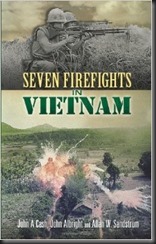”Seven Firefights in Vietnam” is a collection of seven reports describing specific combat actions in Vietnam that took place between 1965 and 1968. Five of the reports deal with engagements involving forces of battalion size, one describes an ambush by a mere squad, while the final chapter is dedicated to a fire support mission by an element of two Huey helicopters configured as fire-support birds.
The narrative is consistently of ‘after action report’ variety – brief, strictly descriptive, no dialogs or deeper analysis of events or decisions. Orders are given, units maneuver here or there, engage the enemy, fire is exchanged, casualties taken… rewind and repeat. While the writing style is definitely austere, the authors manage to give a pretty clear picture of chain of events and character of individual engagements. If that’s what the reader wants from this book, then he will be satisfied. If reader’s expectations go beyond mere report of events, then I’m afraid that this book will turn out to be something of a disappointment.
Selection of after action reports included in this volume is also something of a problem. The first of them, which is also the longest one, deals with battle at Ia Drang, made famous by the “fantasy” movie “We were soldiers once” couple of years ago. It’s inclusion in this volume is perhaps the most logical, since it was a first action involving air-mobile unit of battalion size and something of a test of the concept that has later become synonymous with Vietnam war. The narrative of action at Dak To in 1967 where a battalion size search & destroy mission was hit by a Vietnamese ambush seems also to be quite representative for combat actions of that conflict. The rest of this book is however something of a mystery for me. Remaining chapters describe an ambush against a large vehicle convoy with AVAC squadron acting as escorts, a huge battle between riverine units and extremely well-entrenched opposition, a small scale night ambush by a single squad, an assault against a major firebase which is not only successful but in which the Vietnamese use a company of tanks (!!!) and finally a fire support mission by a couple of ‘Hogs’. This selection surely provides a lot of diversity, but it also makes it very hard for me to understand the purpose of this book.
A reader genuinely interested in and already knowledgeable about Vietnam conflict will find a lot of interesting material in this book. For remaining audience it will probably be a very dry and ultimately unsatisfactory book.
For a wargamer, “Seven Firefights in Vietnam” is however a must buy, if one’s interested in Vietnam conflict. Each of five large engagements covered in the volume will easily provide material for a large reinforced battalion-size scenario. If split into smaller components, each of those chapters can be split into several company-size or even mass skirmish games. There are however two weak spots – the maps included in the book are inadequate and scenario designers will have to make their research. Also, the Vietnamese OOB:s are very rudimentary. This in itself is hardly surprising – the volume was first printed in 1970, while the conflict was still ongoing. But it’s a bit annoying nevertheless, because I doubt there are many books about Vietnam conflict that also resemble scenario books so closely as this little book!

No comments:
Post a Comment